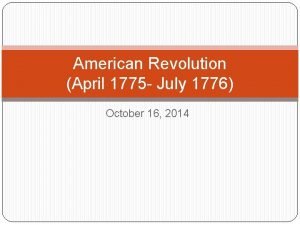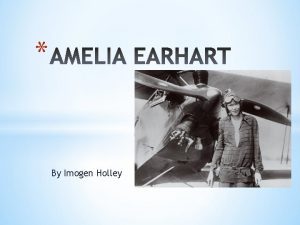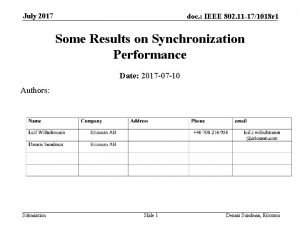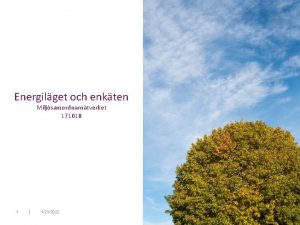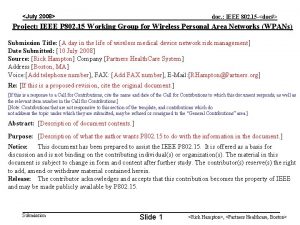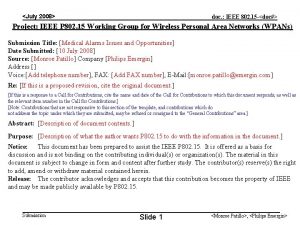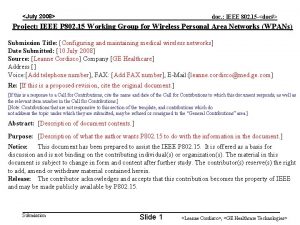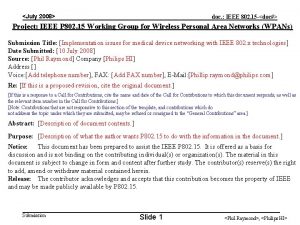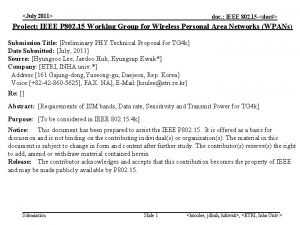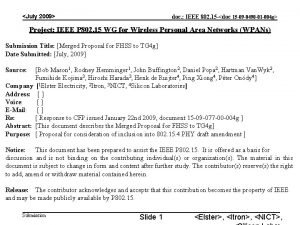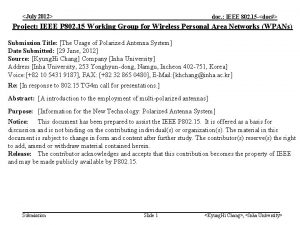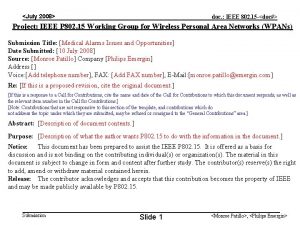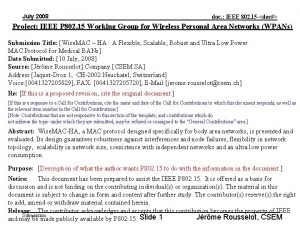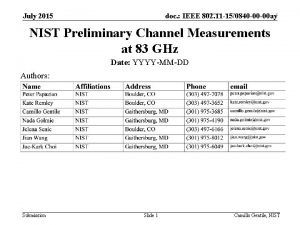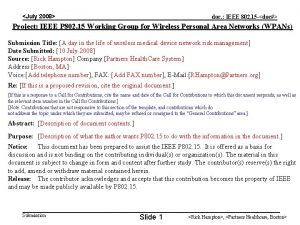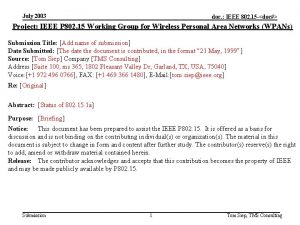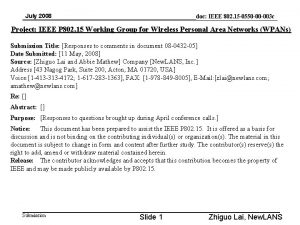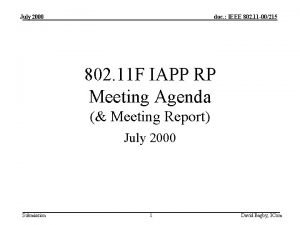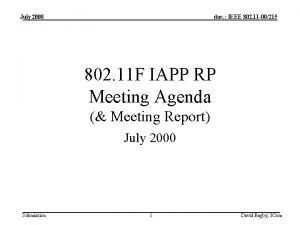July 2017 doc IEEE 802 11 171018 r

![July 2017 doc. : IEEE 802. 11 -17/1018 r 0 Abstract • In [1] July 2017 doc. : IEEE 802. 11 -17/1018 r 0 Abstract • In [1]](https://slidetodoc.com/presentation_image_h2/9e7e99250d60273d7bd14c609890bf5e/image-2.jpg)

















- Slides: 19

July 2017 doc. : IEEE 802. 11 -17/1018 r 0 Impact of WUS Bandwidth on Synchronization Performance Date: 2017 -07 -XX Authors: Submission Slide 1 Dennis Sundman, Ericsson
![July 2017 doc IEEE 802 11 171018 r 0 Abstract In 1 July 2017 doc. : IEEE 802. 11 -17/1018 r 0 Abstract • In [1]](https://slidetodoc.com/presentation_image_h2/9e7e99250d60273d7bd14c609890bf5e/image-2.jpg)
July 2017 doc. : IEEE 802. 11 -17/1018 r 0 Abstract • In [1] it is shown that the PER performance is improved if the bandwidth of the WUS as well as the channel selective filter is increased using a relatively long syncword • In this presentation we investigate how long syncword is needed for different coding schemes and also how this required length depends on the bandwidth of the WUS • It is found that for the same path loss, a system using a wider bandwidth may only require a syncword of half the length compared to a 13 sub-carrier system, leading to additional gain on top of what is already achieved by allowing for higher data rate Submission Slide 2 Dennis Sundman, Ericsson

July 2017 doc. : IEEE 802. 11 -17/1018 r 0 Outline • Recap of link budget considerations • Motivation • Simulations • Simulation set-up & performance metric • Performance in AWGN • Performance in Frequency selective channels • Conclusions • Straw polls Submission Slide 3 Dennis Sundman, Ericsson

July 2017 doc. : IEEE 802. 11 -17/1018 r 0 Motivation • To obtain a spectrum efficient transmission, the length of the synchronization word should be as short as possible, still giving sufficient performance • Here we present simulation results for synchronization performance and relate this to the corresponding performance of the data presented in [1] • In particular, we discuss the gain in spectrum efficiency that can be achieved by using a large bandwidth of the channel in demanding channel conditions as proposed in [1] Submission Slide 4 Dennis Sundman, Ericsson

July 2017 doc. : IEEE 802. 11 -17/1018 r 0 Model for receiver processing CSF - ADC Env. Det. 4 correlator |. | LPF • ADC runs at 4 x oversampling relative WUS symbol rate • Correlator (coeff. +-1) operating on signal with DC bias • Manchester coding used, so no need to estimate the decision threshold DC • CSF selected to signal BW + 500 k. Hz Submission Slide 5 Dennis Sundman, Ericsson

July 2017 doc. : IEEE 802. 11 -17/1018 r 0 Varying the signal bandwidth Frequency 4 MHz 8 MHz 16 MHz • The power of the WUS is boosted by allocating more sub-carriers to the WUS • The smallest BW corresponds to the 13 sub-carriers first proposed in [7] Submission Slide 6 Dennis Sundman, Ericsson

July 2017 doc. : IEEE 802. 11 -17/1018 r 0 Simulations – AWGN channel • Assuming that the PER target is 10%, it is reasonable to have a synchronization error target of 1% • In a similar way as for the data performance, the gain by reducing the bandwidth 2 x is around 1 d. B, effectively meaning a 2 d. B gain in link budget for a 2 x increase in signal bandwidth due to increased TX power Submission Slide 7 Dennis Sundman, Ericsson

July 2017 doc. : IEEE 802. 11 -17/1018 r 0 Example 1 – AWGN - 13 sub-carriers • Synchronization error < 1% at a PER of 10% gives required syncwords lengths of 24, 40, and 64 bits, respectively • Using 64 bits at all times would mean a waste of 160 us, corresponding to 20 bits in a 125 kb/s packet Submission Slide 8 Dennis Sundman, Ericsson

July 2017 doc. : IEEE 802. 11 -17/1018 r 0 Example 2 – AWGN – 52 sub-carriers • Synchronization error < 1% at a PER of 10% gives required syncwords lengths of 24, 40, and 64 bits, respectively • The change in signal bandwidth does not change the relative performance of synchronization and data Submission Slide 9 Dennis Sundman, Ericsson

July 2017 doc. : IEEE 802. 11 -17/1018 r 0 Simulations – TGn B/D channel Submission Slide 10 Dennis Sundman, Ericsson

July 2017 doc. : IEEE 802. 11 -17/1018 r 0 Example 3 – PER = 10% Manchester coding 125 kb/s • Select the SNR such that PER ~ 10% for ideal sync • Change syncword length • Channels: AWGN, TGn. B, and TGn. D • Choice of syncword length 24 seems sufficient Submission Slide 11 Dennis Sundman, Ericsson

July 2017 doc. : IEEE 802. 11 -17/1018 r 0 Example 4 – PER = 10% Manchester coding + convolutional coding • Select the SNR such that PER ~ 10% for ideal sync • Change syncword length • Channels: AWGN, TGn. B, and TGn. D • Choice of syncword length 40/48 seems sufficient Submission Slide 12 Dennis Sundman, Ericsson

July 2017 doc. : IEEE 802. 11 -17/1018 r 0 Example 5 – PER = 10% Manchester + conv. + 2 x rep coding • Select the SNR such that PER ~ 10% for ideal sync • Change syncword length • Channels: AWGN, TGn. B, and TGn. D • Choice of syncword length 64 seems sufficient Submission Slide 13 Dennis Sundman, Ericsson

July 2017 doc. : IEEE 802. 11 -17/1018 r 0 Example 6 – Comparing bandwidths • As a benchmark, take 13 sub-carrier WUS received at SNR = -10 d. B • For equivalent pathloss, the reiceved SNR in case of a 52 sub-carrier WUS would be -4 d. B • Suppose the data part of the packet is 64 bits • For 13 sub-carriers, this means 62. 5 kb/s and 40 bits syncword => 1. 18 ms • For 52 sub-carriers, we have 125 kb/s and 24 bits syncword = 0. 61 ms. The change in signal bandwidth does not change the relative performance of synchronization and data Submission Slide 14 Dennis Sundman, Ericsson

doc. : IEEE 802. 11 -17/1018 r 0 Additional benefits • The length of the sync word can be used for detecting the MCS Submission

doc. : IEEE 802. 11 -17/1018 r 0 Conclusions • Different syncword length can be used for different MCS • For less coding, shorter syncwords suffice • The length of the syncword is independent of the bandwidth used for the wake-up signal • The length of the syncword can be used to detect the MCS Submission

July 2017 doc. : IEEE 802. 11 -17/1018 r 0 Straw Poll • Do you support to add to the SFD that the length of the syncword for the wake-up signal may be varied depending on data rate in the wake-up packet? Y/N/A: 0/0/0 Submission Slide 17 Dennis Sundman, Ericsson

July 2017 doc. : IEEE 802. 11 -17/1018 r 0 Straw Poll • Do you support to add to the SFD that the bandwidth used for the syncword may be selected independently of the bandwidth used for the data part of the packet? Y/N/A: 0/0/0 Submission Slide 18 Dennis Sundman, Ericsson

July 2017 doc. : IEEE 802. 11 -17/1018 r 0 References 1. L. Wilhelmsson et al. “Variable signal bandwidth of the wake-up signal for enhanced WUR performance”, IEEE 802. 11 -17/1017 r 0. 2. M. Park et al. , “Low-power wake-up receiver (LP-WUR) for 802. 11, ” IEEE 802. 11 -15/1307 r 1 3. J. Liu et al. , “On waking-up multiple WUR stations, ” IEEE 802. 11 -17/0028 r 0 Submission Slide 19 Dennis Sundman, Ericsson
 Bridges from 802.x to 802.y
Bridges from 802.x to 802.y Bridges from 802.x to 802.y
Bridges from 802.x to 802.y Ieee 802 standard
Ieee 802 standard Bluetooth ieee 802
Bluetooth ieee 802 802 ieee
802 ieee Ieee 802
Ieee 802 Ieee 802 family
Ieee 802 family Ieee 802 3 compliance
Ieee 802 3 compliance Ieee802.22
Ieee802.22 Arquitetura ieee 802
Arquitetura ieee 802 Estandares ieee 802
Estandares ieee 802 July 16 1776
July 16 1776 July 1-4 1863
July 1-4 1863 Recognizing imagery
Recognizing imagery Ctdssmap payment schedule july 2021
Ctdssmap payment schedule july 2021 July 30 2009 nasa
July 30 2009 nasa Malaga in july
Malaga in july July 2 1937 amelia earhart
July 2 1937 amelia earhart On july 18 2001 a train carrying hazardous chemicals
On july 18 2001 a train carrying hazardous chemicals Miss cuba receives an invitation
Miss cuba receives an invitation











